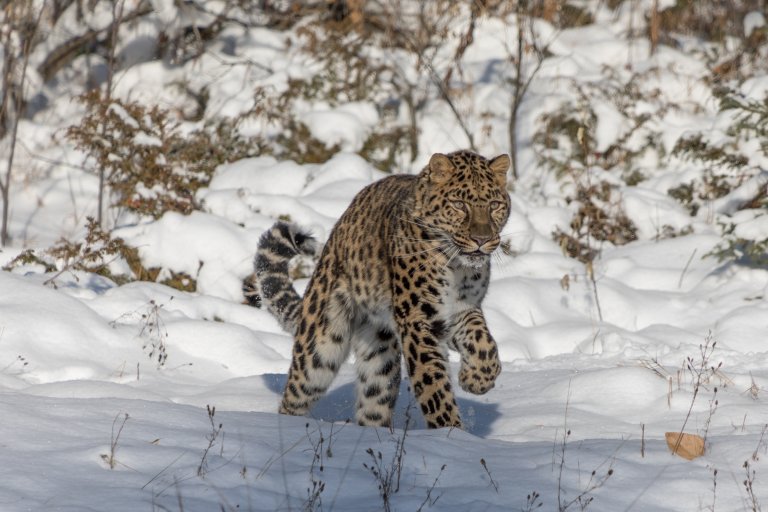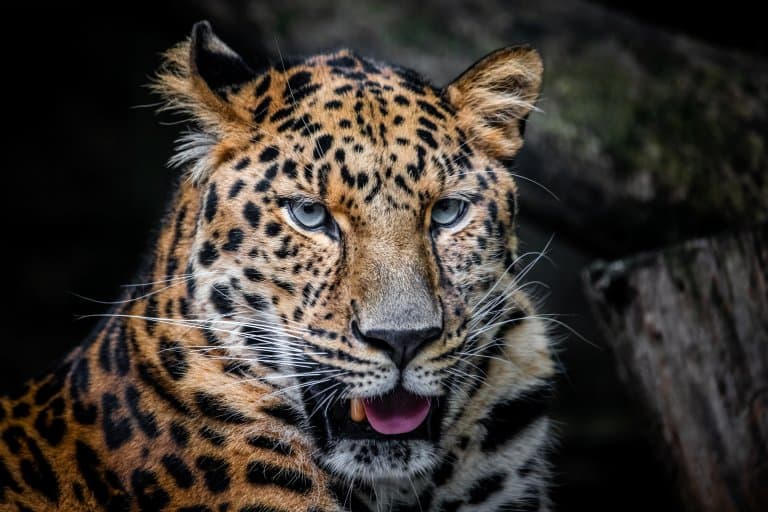Amur Leopard Profile
Ten thousand kilometres Northeast of Kenya there’s a cat whose scarcity has inspired great action on the part of international zoo associations.
The Amur leopard is the critically endangered subspecies of the famous African safari attraction; an animal who has been persecuted for its good looks to the point of becoming the rarest cat on earth.
This subspecies resides in southeastern Russia and northeastern China and is sometimes referred to as the Siberian leopard, Manchurian leopard, far eastern leopard, or Korean leopard.

Amur Leopard Facts Overview
| Habitat: | Cold mountainous areas, broadleaved and conifer forests |
| Location: | Southeastern Russia and Northern China |
| Lifespan: | 15 years in the wild, 20 in captivity |
| Size: | 1.4 m (4.6 ft) long |
| Weight: | Up to around 48 kg (106 lb) |
| Color: | Pale cream-colored fur, varies from fairly light yellow redish with a golden tinge |
| Diet: | Deer and smaller mammals |
| Predators: | Humans |
| Top Speed: | 58 km/h (36 mph) |
| No. of Species: |
1 (8 subspecies) |
| Conservation Status: |
Critically endangered |
Amur leopards are well adapted to the cold environment and often inhabit mountainous areas, close to hunting trails and migration routes of wild animals.
These stealthy felines are opportunistic carnivores and are often called ‘the silent killer’. They will prey on a variety of animals, such as sika deer, elk, wild boar, badgers, hare and mice.
The Amur leopard has been reduced to populations that may be as low as double-digits. Yet, concentrated conservation action and the animal’s natural resilience have started to see the tide turn.
This is a perfect case study of the benefits of and necessity for effective conservation efforts both in the wild and inside accredited zoos, and their ability to bring a species (or in this case, a subspecies) back from the brink of extinction.
The Amur leopard is not out of the woods yet, and it still faces legitimate threats from human encroachment, but within the next couple of decades, and as long as efforts don’t let up, we could see it bumped up a status.
Interesting Amur Leopard Facts
1. They are the rarest big cats
These leopards are said to be the rarest to see in the wild and may be the most endangered cat on earth. Some estimates suggest only 100 remain in the wild, others as low as 60, with most claiming no higher than 120.
These big cats live in some very remote regions. They’re also mostly nocturnal, making the chances of stumbling on one even slimmer. 1

They are high on our list of The Most Endangered Animals in the World.
2. They’re one of the big five
The Amur leopard is a subspecies of the African leopard, considered the cat with the widest distribution on Earth. Panthera pardus is listed as vulnerable on a global scale, and locally extinct in numerous countries it once called home.
The Amur leopard subspecies, Panthera pardus orientalis is probably the closest to extinction. While their habitat has plenty of room for more leopards in it, their issue is primarily related to poaching.
3. They’re apex predators
As predators at the very top of their natural food chain, these are significant influences on their ecosystems. Apex predators create the upper bound for the animals that occupy the lower niches and are as relevant to communities as the plants that form their foundation.
Amur leopards are creatures of habit, following the same hunting trails and occupying the same sleeping areas, month after month. Once they’ve chosen a territory, they’ll stick with it, remaining solitary until it’s time to breed.
Within these territories, the leopards would naturally be keeping a healthy balance of biodiversity, and this makes their survival important to the ecosystems of vast forest networks in Russia and China.
However, their incredible fur brings a high market value and makes them an appealing target for poachers.

4. Their pale cream-colored fur distinguishes it from other subspecies
While subspecies of leopard can be hard to separate in appearance, the thicker, paler cream-colored fur of the Amur leopard distinguish it from other leopard subspecies.
Particularly in winter, when the length of their coat hair can grow from 2cm in the summer up to 7cm for the cold, harsh climate with heavy snowfall.
Amur leopards also have have longer limbs and wider paws for walking through deep snow, and can wrap their tail around themselves to keep warm.
Each leopard has unique rosette patterns, that help identify each individual like fingerprints of humans.
5. They can take down prey 3 times their own weight
Amur leopards are relatively small in body size measuring between 82–136 cm (32–54 in) and weighing 25–48 kg (55–106 lb), which is around 13-14 kg (30 lb) smaller than their African counterpart.
Their prey typically consists of ungulates, such as sika deer, elk and boar and their immense strength allows them to take down even larger prey.
They are capable of carrying their meal into trees, so their food is not taken by other predators.

6. Anti-poaching programs seem to be working
High levels of protection and effective enforcement of laws have possibly begun to increase the population of Amur leopards in protected areas.
Numbers are said to be rising as a result of some heft fines and threats of imprisonment. In Russia, poachers can be fined tens of thousands of dollars, and possession of their fur comes with similar penalties and possible jail time.
This is more than ten times the amount the fur would make on the market in Russia, so it works well as a deterrent, as long as it’s enforced. 2
7. But poaching only tells part of the story
While the restriction on direct hunting of Amur leopards is significant and seemingly effective, other threats to the species come from the classic cases of habitat fragmentation and resource competition.
Human population increases bring with them increased demand for meat from the forest, putting them in direct conflict with the leopards for food, and chopping up their forest habitats into agricultural, transport and urban terrain.
8. They stand a good chance of rebounding
Many factors make the leopard a resilient animal. Despite their solitary nature, they adapt well to different hunting grounds. Females can breed at any time of the year, and cubs are independent by 16 months.
Breeding dens are usually on cliff faces and rocky outcrops, well away from human interference.
This provides a fast reproductive cycle that should allow these leopards to expand back into their natural niches if left alone, though the range of dispersion for offspring is limited by habitat fragmentation.
9. They aren’t particularly dangerous
Leopards are large, powerful predators, but they’re very shy and secretive, too. While there may be some overlap in human and leopard patrols, the chances of an attack are very slim.
Still, with prey scarcity on the rise for Amur leopards, these chances do increase, further emphasising the importance of a balance between human and wildlife resource exploitation in the forest.
Each individual has a range of up to 300km, signifying the importance of wide stretches of uninterrupted habitat to their survival. 3
10. Breeding programs could help
In 1961, a captive population of Russian leopards was bred from nine individuals. However, the offspring didn’t resemble the wild variety as much as expected, and it was found that they had accidentally been bred with a very similar Chinese subspecies.
This is a huge red flag when it comes to reintroduction, as breeding programs must keep an accurate cross-section of wild gene availability to each region; introducing new breeds could have serious adverse effects.
However, it was established that this overlap in genetic composition was the cause of a healthy amount of overlap in the two subspecies and that the products of the breeding program would be fit for reintroduction.
In fact, since the separation of the two subspecies was mostly human-caused, it was thought that the accidental mix-up would create animals that even more reflected the pre-human populations than they do now and may even be a better fit.
Currently, four regional zoo associations manage ex-situ programmes for Amur leopards and participate in the WAZA Global Species Management Plan (GSMP), established in April 2013. They have managed to retain 91% gene diversity and had as many as 217 individuals across 88 institutions by 2018. 4

Amur Leopard Fact-File Summary
Scientific Classification
| Kingdom: | Animalia |
| Phylum: | Chordata |
| Class: | Mammalia |
| Order: | Carnivora |
| Family: | Felidae |
| Genus: | Panthera |
| Species Name: |
Panthera Pardus |
| Subspecies Name: |
Panthera Pardus Orientalis |
Fact Sources & References
- Nick A. Romero (2022), “Different Types of Leopards“, AnimalWised.
- “Top 10 facts about Amur Leopards“, WWF.
- Anna V. Vitkalova (2016), “A complex approach to study the Amur leopard using camera traps in protected areas in the southwest of Primorsky Krai (Russian Far East)“, CyberLeninka.
- O’Brien, S. J., & Johnson, W. E. (2005), “BIG CAT GENOMICS“, Annual Review of Genomics and Human Genetics.
